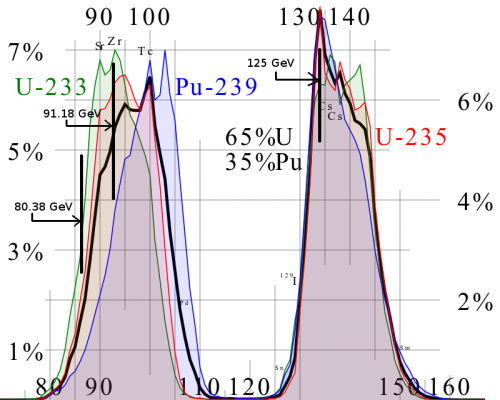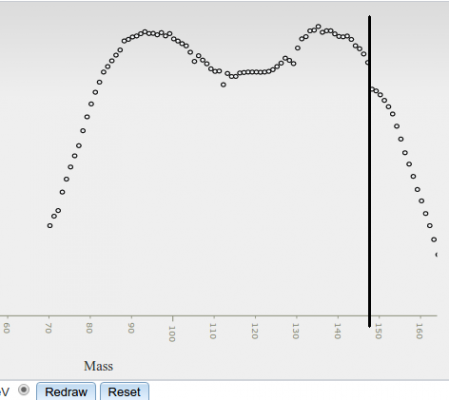

arivero
Members-
Posts
20 -
Joined
-
Last visited
Contact Methods
-
Website URL
http://dftuz.unizar.es/%7Erivero/research/
Retained
- Quark
arivero's Achievements

Quark (2/13)
10
Reputation
-

Beta decay, or a corner of the Higgs Sector
arivero replied to arivero's topic in Modern and Theoretical Physics
Now that the higgs mass is known, I have updated some plots. A very interesting one, that I did not noticed in 2004, was this one, for hot neutron-induced fission of 235U were an enhancement of the fission yield seems to happen when the mass of the small fragment is about 235 - 147 u The previous plot of beta decays can benefit of the Higgs mass, but it is interesting to look at it in yield histograms, as really the number of betas in the database depends of the number of nuclei we have measured. So: I have put some extra plots in a vixra document http://vixra.org/abs/1509.0090 -
The guy is right, just it is using a different definition of PI, which is a very stupid thing to do. This "varying Pi" has a name, it is a measurement of the curvature of space. Note that there are other flat definitions for pi; for instance the sum of angles of a triangle, and I am not sure all will vary the same way. Better stick with the well defined, century old, concepts of curvature.
-

A simple homemade Atomic Reactor
arivero replied to YT2095's topic in Modern and Theoretical Physics
-

A simple homemade Atomic Reactor
arivero replied to YT2095's topic in Modern and Theoretical Physics
In any case, the real serious matter is the H-bomb. As for A-bombs goes, even conventional explosives are already in the range. -

A simple homemade Atomic Reactor
arivero replied to YT2095's topic in Modern and Theoretical Physics
Gammas are Force fields, while electrons etc are Matter fields. Force fields are usually offshell, while matter happens to be usually onshell. But gamma has the peculiarity of having null mass, so it is easy for them to be on shell, then we call it electromagnetic radiation. -
Kabbala for numbers is mostly Mid Age art. About alphabets a interesting point is that the "phonetical" alphabet was invented once, than copied along the whole Earth. In very exotic cases -Armenians?- the local ruler preferred to invent a completely different set of signs, but mostly are derived from the original ones. This includes the alphabet used in Hebrew language. The ordering of letters was already fixed a lot of time ago, perhaps XIIIth century BCE. But the mapping from letters to numbers comes surely later, for very technical applications as astronomical recordings etc, already in the alexandrian or roman times. It seems that sequences as the roman I II III IIII V (one hand) VI VII VIII VIIII X (two hands, V and ^ ) XI ..., even if error-prone, were more appealing to most people.
-
I think it was Doplicher (of axiomatic/algebraic field theory fame) whom ten years ago proposed to get quantum geometry indeterminacy from the postulate of impossibility of microscopic black holes. Ie that geometry has an indeterminacy relation just because too much energy in a space time are creates a black hole. Or perhaps it was Fredenhagen. Oh, memory!
-
Do you mean Jupiter moons etc?
-

A simple homemade Atomic Reactor
arivero replied to YT2095's topic in Modern and Theoretical Physics
Mostly the still is used to process heavy water, so grand'pa should not worry about it... well, perhaps some residues of uranium hexafluoride... but, anyway, if he can cope with the methanol, this will not kill him And yep, in the XIXth century "glow in the dark" glasses were sold. Nice bohemians, finally finding some use for the hot stones. -

A simple homemade Atomic Reactor
arivero replied to YT2095's topic in Modern and Theoretical Physics
Hmm but I can imagine someone accumulating pitchblende for years in the cellar of his house at the mountain, the stones sitting there just next to the grand-father whyskey alambic... -

A simple homemade Atomic Reactor
arivero replied to YT2095's topic in Modern and Theoretical Physics
It is horrible that one thinks before on going shopping for old clocks to get a bit of radioactive substance instead of going to the open country for the minerals. The only science people learns modernly is "consumer science". -

Beta decay, or a corner of the Higgs Sector
arivero replied to arivero's topic in Modern and Theoretical Physics
NZ.jpg is simply the bidimensional view of bhist.jpg -

Beta decay, or a corner of the Higgs Sector
arivero replied to arivero's topic in Modern and Theoretical Physics
id=309 was well explained in the preprints 0405076 and EXT-2004-048 in the website, where a different image was used but the argument and method was the same. As in the extant attachment (NZ.jpg), the plot disposes the nuclei in a surface according number of neutrons and protons. Then nuclei having approximately the same nuclear mass (same atomic number A) are disposed in diagonal. I underline the diagonals for some mass of interest, and then I also plot the lines marking nuclear magic numbers. The point there is that the cross between magic number lines and our diagonals happens always very near of the drip lines. Or conversely, given the mass and the drip lines, we can estimate where the magic numbers are going to be. This hints strongly that besides spin orbit, a contribution to magicity could come from the particles on the Higgs/electroweak sector. The image id=309 shows proton and neutron drip lines calculated for four different nuclear models. The plots are got from a work of Uno, a Japanese scientist and burocrat, and the whole image is given to suplement the ones in the preprints. 0405076 uses only the very simple drip lines from a 1993 preprint on the FRDM mass model, and EXT-2004-048 uses a different (russian?) model that calculates 2-p and 2-n drips, but in exchange it also estimates the proton and neutron skin radius. -

Theory of Everything (Superstring theory)
arivero replied to Adrian's topic in Modern and Theoretical Physics
It did seem, to me, an article from Witten the journalist, not Witten the scientist. Just a status report. He mentions the last trendy thing in astrophysics, the dark energy, and he stress a lot the possibilities of SUSY. Personally, as I indicated in other thread, I am being progressively forced to consider the reality of the 68 GeV charged scalar, which rules out the minimal supersymmetric standard model. I have not idea if SUSY will survive the test. I would like to speculate that the mass of the top quark signals a remain of surprisingly low energy SUSY, being the top of the same mass scale that the fundamental bosons. It even could exist a boson degenerated in mass with the top; we have not reached this energy range yet. By now it seems it is slowing down. But the run has wiped about a lot of other approaches, that have been forced to run along with them or to sunk under their heels. Some months ago I described this process as "the flood". I have a remembrance of a seminar room with some physicists from other field having a small meeting, and taking awareness of the fact that string theory was showing an interest not on his work, but on his field. It felt as being in a hunting log down in the valley and hearing the breaking noises of the barrage up the river. -

Theory of Everything (Superstring theory)
arivero replied to Adrian's topic in Modern and Theoretical Physics
Well the important thing is that they are trained to sit down for hours theorising, a very needed habit. Now, there is a deeper issue in the training of physicists, and it is that the scoring system during undergraduate and graduate studies is oriented towards discussing and solving problems, with a very small focus on focusing, locating or priorising problems. The final result of the training system is a herd of people that enjoys to discuss and to solve problems. Any kind. I mean, any. They do not worry if they are very far away real physical interest nor meaning; they are happy equally if they can solve them and if there are a lot of people to discuss and show the solutions they get.


